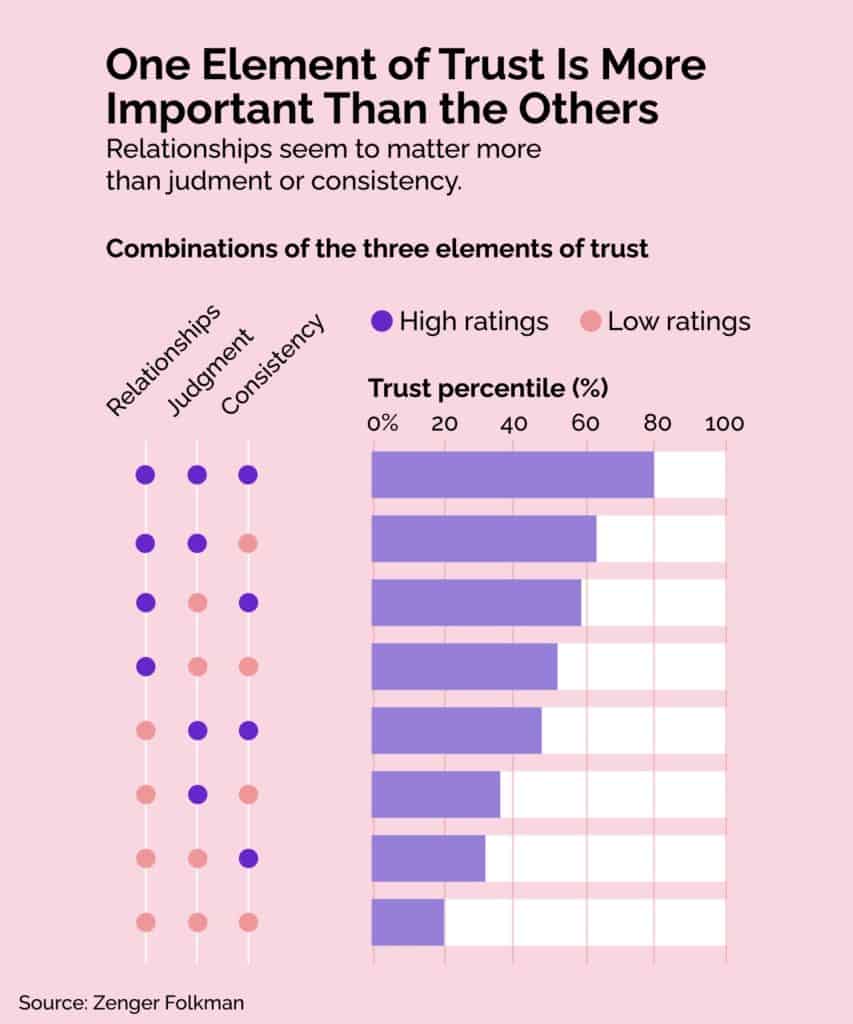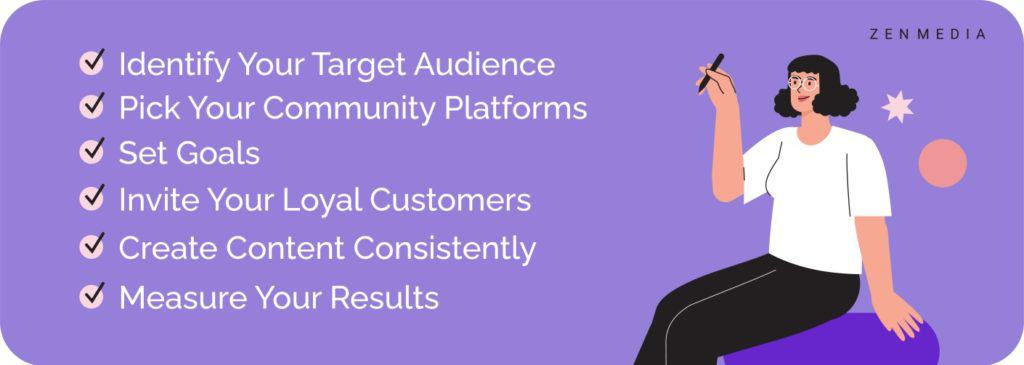Picture this: you’re about to see your favorite band play a sold-out concert. Standing among a sea of fans, you anxiously wait for the show to begin. Then, the lights go out. The crowd cheers in anticipation as four silhouettes appear onstage with instruments. You hear the opening chord to your favorite song ring out, and the lights come back on. Suddenly, you hear yourself and a crowd of 1,000 strangers singing along to every word.
Shared experiences and shared spaces are a large part of building relationships and a community, both of which are integral to building trust.
In fact, relationships are the most important part of trust-building, even outweighing judgment and consistency.

This is why building relationships has to be a part of modern-day marketing. And interestingly enough, it isn’t just a customer’s relationship with a brand that matters. Customers’ relationships with one another are also vital because customers trust other customers more than they trust brands. This is why social proof—like user-generated content (UGC), reviews, and testimonials—are so important.
Related reading: Why Your B2B Marketing Strategy Needs Sales Collateral
And that social proof becomes stronger and more valuable when it comes from multiple trustworthy sources (i.e., from more than one customer—like a community of customers). Think about it. When you join an online community for your favorite TV show, sharing your opinions on the show and discussing favorite characters and episodes help you and others in the community become more invested in the show due to your shared experience. Then, if someone in the community recommends another show, everyone in the community is more likely to check it out because it came from someone with a shared interest—someone you all trust due to your relationship.
While your brand may not be tied to entertainment, the same theory applies. This is why it is so important for businesses to build and manage communities with their clients.
Marketers, get ready to take notes. Here is the Ultimate Guide to Community Management for Marketers.
What is Community Management?
What does creating a community mean in the context of a brand? According to Hubspot, “Community management is the process of building an authentic community among a business’s customers, employees, and partners through various types of interaction.”
Successful community management strategies allow businesses to:
- Build more personal relationships and communication channels with users.
- Receive feedback and ideas from customers.
- Create value behind the product.
- Boost sales and brand loyalty.
While social media platforms play a great role in connecting users with businesses, most social media marketing strategies are more focused on raising brand awareness than building relationships and fostering a community. While responding to Instagram comments and Twitter mentions are great ways to interact with followers, conversations in the comments of traditional social media platforms don’t necessarily build strong engagement between audience members. While customers may engage with the brand—which is great and necessary—they aren’t as likely to have meaningful engagement—or ongoing engagement—with other audience members, which is an important part of building a community.
Plus, brands rely on the algorithm of traditional social media platforms to increase their reach. This can make meaningful engagement more challenging to achieve since so many pieces of content are fighting for the top spots on user feeds.
This is why we’re seeing a rise in community management tools like Discord and Mighty Network—where users can engage and build relationships with each other more effectively in their own spaces. And brands can do the same—creating custom spaces for customers and prospects to discuss the pros and cons of products, ask questions, and get recommendations.
Related reading: Discord: What Is It and How Can You Use It For Marketing?
As customers build relationships with one another based on their shared use of a brand’s products, the business can respond to customer questions and concerns without the high visibility of social media. And they can also get useful data about what their customers want—straight from the horse’s mouth.
The ABCs of Community Management for Marketers
So community management is just joining Discord or the Might Network and seeing what people are saying?
Not exactly. As with all aspects of marketing, there are key strategies and ways to engage with your community that will help build strong relationships and help you actually move the needle. At Zen Media, we call these the ABCs of Community Management.
Let’s learn our letters, shall we?
A: Advocacy
This type of community management puts your customers into action and allows them to be the face of your brand.
Akin to B2B influencer marketing, advocacy is all about giving your biggest supporters the opportunity to work with you on promotional campaigns. The goal here is to have the most engaged members of your community build your brand’s awareness—and hopefully, drive more sales.
Creating a brand ambassador program is a great way to incentivize your customers to help spread the word. In exchange for discounted products or free merchandise, ambassadors are asked to make social media content, represent the brand at events, and continue word-of-mouth marketing tactics.
Maker’s Mark is a great example of a company that continues to grow with its brand ambassador program. The Kentucky Bourbon staple sends special invitations to the customers they want fully involved. In return, they ask these special customers to share their loyalty to the brand with everyone they can. Maker’s Mark is known for giving fantastic holiday gifts and invites to exclusive events. It takes half a decade for a bourbon barrel to be ready, and thus, the company wants to create long-term connections with its customers.
B: Brainstorming
The brainstorming strategy is a combination of social listening and direct interaction.
Listen to the conversations that are happening in your community, and see how they can be used to improve existing products or create new ones. Loyal customers often have strong opinions and ideas about the direction a brand should go, and brands can fulfill these desires and predictions by listening and acting.
The brainstorming strategy doesn’t just need to be reactive, though. You can also bring your customers into the testing and brainstorming processes by asking them for their ideas and feedback. Surveys and round-table discussions are great ways to learn more about what your customers are looking for and work together on great solutions.
Think of apps like Mighty Networks as digital focus groups. Marketers have relied on focus groups for ideation strategies for a very long time. They are successful because they allow businesses to receive honest responses from real customers. Now that the process is digitized, customers can share their thoughts and opinions with the touch of a button.
Customer engagement increases, and your knowledge of your target audience is enhanced.
C: Custom Content
When you create a tight-knit community, you want to offer them programming that is unlike your typical social media posts. This is why it is important to create B2B content that is dedicated to your members via these channels. It is also a great way to inspire community members to create their own content.
Fun pieces of content and programming can include:
- Exclusive podcasts that answer community members’ questions or engage on hot topics
- Members-only contests and giveaways
- Crowdfunding campaigns
- First looks at new products and features
- Exclusive videos that give insight into what it’s like to work for the brand, sneak peeks, behind the scenes, and more.
The more you can offer the community, the more engaged and willing they will be to sing your brand’s praises!
D: Documentation
As noted before, community management tools are great ways to offer customer support. A key strategy for supporting your customers is by documenting tips, tricks, FAQs, and more.
Brands can create a “FAQ” forum where users can ask questions and receive answers directly from the brand. This is an efficient way to offer support that is also personal. How many times have you left an AI-Chat Bot feeling like you did not receive any assistance? Forums like these eliminate this problem and give brands the one-on-one ability to help customers succeed.
On these forums, fellow customers can also share their experiences and offer solutions as well. Giving customers the ability to help each other and speak passionately about your brand is a great way to increase loyalty and turn first-time customers into returning ones.
And the best part? It’s all documented, so future customers can find this valuable information as soon as a question arises. To make things extra convenient, we recommend taking the FAQs from your community engagement and adding them to your website on an FAQ page.
E: External Outreach
While community management strategies are strongest when used in focused community platforms like Discord, it is important to stay engaged on external sites as well. Social media management goes a long way when persuading first-time customers to return and become more involved, and that means external outreach.
On your traditional social media platforms like Twitter, LinkedIn, Facebook, and Instagram, make sure you aren’t neglecting those who comment on your posts. Write personal replies to comments, reshare pieces of content made by other users, and create CTA’s for followers.
Wendy’s is an example of a brand that uses social media to its advantage. It engages with first-time and long-time audience members through sassy tweets and roast sessions. While most marketers could argue that dissing one’s fanbase is not a smart strategy, Wendy’s does so with a lighthearted and lovable tone. Their playful content helped them win the brand the number one spot on Fast Company’s 2019 Most Innovative Companies list in the social media category.
While external outreach tends to be focused on more traditional platforms, it is absolutely necessary for the Discords, Might Networks, and Reddits of the world too. In this case, outreach looks like joining channels for topics related to your brand and engaging with those users to help draw them to your own brand’s channel. For example, if you are a B2B SaaS company, join communities that are about software more generally, and help provide insights that may lead the audience of that community to your own community. Or think about how your particular SaaS helps companies and see how that may tie to other communities.
If you are a personal finance platform, join money diary channels and provide tips that subtly mention using your own tools to help improve money management.
External engagement works in tandem with these other community management strategies by bringing new members to the community and enabling them to build relationships with loyal community members. Keep it up, and you will earn fans for life.
An Overview of Community Management
Are you ready to get started on your community management journey? Now that we’ve given you a few ideas on how to get the ball rolling, here are some steps you need to take:

- Identify Your Target Audience: Where do they live? What platforms are they most active on? What do they like? Why do they need your product?
- Pick Your Community Platforms: Discord, Facebook Groups, and Mighty Networks are all great examples. What works best for you and your brand?
- Set Goals: What are your intentions when building your community? Do you want to drive sales and/or online awareness?
- Invite Your Loyal Customers: Tell your best consumers about this new platform. Invite them with open arms (and incentives).
- Create Content Consistently: Don’t leave your community hanging. If you don’t keep them engaged, they’ll move on.
- Measure Your Results: Listen to your customers, check your analytics, and adjust your goals.
Need help building and managing your community? Contact us, and we’ll work on the ABCs with you.




